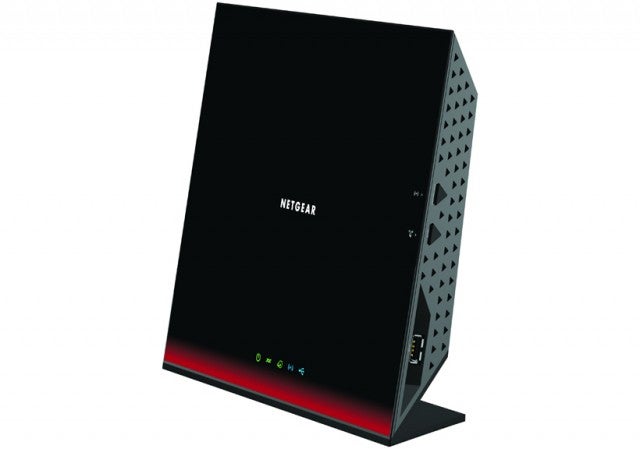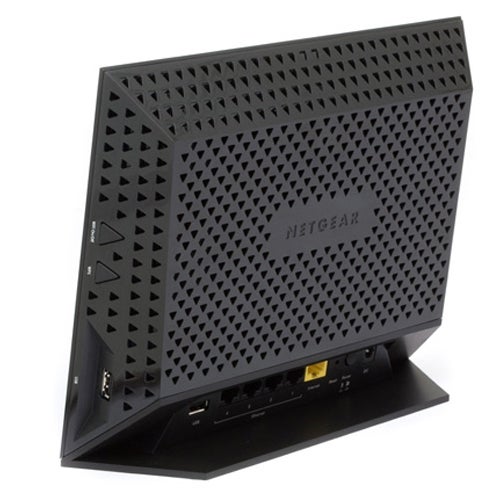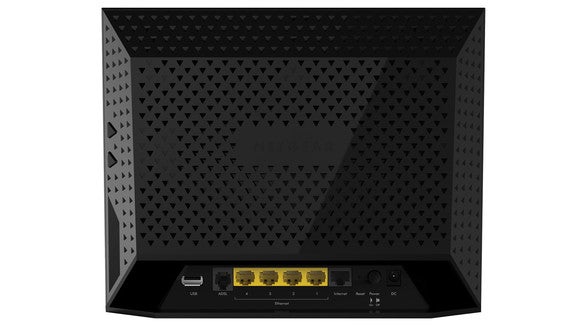Netgear D6300 802.11ac DSL router Review
Netgear D6300 802.11ac DSL router
The first 802.11ac router with integrated modem is both hit and miss.

Sections
- Page 1 Netgear D6300 802.11ac DSL router Review
- Page 2 Setup, Performance & Verdict Review
Verdict
Pros
- Superb 802.11ac performance
- Intuitive user interface
- Fair asking price
Cons
- Large and ugly
- ADSL2+ rather than VDSL modem
- Weak 802.11n 2.4GHz range
Key Specifications
- Review Price: £159.99
- 802.11a/b/g/n/ac WiFi
- 4x Gigabit Ethernet
- Integrated ADSL2+ modem
- 2x USB 2.0
- Netgear Genie smartphone apps
What is the Netgear D6300?
This is Netgear’s second 802.11ac wireless router following the Netgear R6300. Unlike its rivals Netgear hasn’t taken a generational leap, but instead made the first wireless ac router with integrated DSL modem and done so at a relatively affordable price. Interestingly Netgear has kept many of the ageing components of the R6300 to achieve this, but claims to have given them a new lease of life through firmware improvements. Can it really have turned overpriced water into well priced wine?
SEE ALSO: Best routers round-up
Netgear D6300: Design
Sit the D6300 and R6300 side-by-side and you’d be hard pushed to tell them apart. Given the R6300 was a top of the line product this may sound like a compliment, but in truth it was an ugly router at launch and seeing it cloned 12 months later hasn’t seen it age gracefully.
Most striking is its size. At 205 x 255 x 77 mm the D6300 is the largest router we have ever tested and its angular design is at once striking yet instantly forgettable. The D6300 also clocks in at a hefty 654g, though there still appears to be a lot of wasted space inside. The D6300 isn’t wall mountable and only sits vertically making it look like an 11-inch laptop propped on its side.
We’re not overly keen on the D6300’s build quality, either. The fingerprint-loving piano black finish of the R6300 remains and the matt black rear looks a little like a string vest. Like the R6300 the D6300 also comes with a hefty power brick you’ll want to keep well out of sight.

Netgear D6300: Features
So the D6300 is no looker, but then again its appeal isn’t skin deep. What differentiates this router from its peers is the integration of an ADSL2 plus modem. This enables the D6300 to be the first 802.11ac single box replacement for outdated ISP routers, making for a much neater upgrade.
The problem is ADSL2 plus is an odd choice. These modems are not compatible with cable or fibre optic DSL connections and max out at 24Mb/s. The solution is VDSL, but costs are higher and even major ISPs like BT choose to ship their BT Home Hub 4 with a separate fibre modem. That said exceptions exist like the FRITZ!Box 3390 and with Fritz!Box only offering 802.11n products at present Netgear has missed a good opportunity to pair this with wireless ac and make something truly cutting edge.
On the plus side we do get a strong implementation of 802.11ac with Netgear maintaining the 3×3 antenna array of the R6300. Frustratingly though 802.11n is scaled back to just 2×2 antennas. This means that while the wireless ac theoretical maximum stays put at 1300Mb/s, it drops to just 300Mb/s for 802.11n – a figure more in keeping with midrange 802.11n routers.
That said Netgear claims the D6300 will perform like a premium model due to smart firmware and it boasts 802.11ac will be a match for any wireless ac router on the market.
Elsewhere there is less controversy. The D6300 packs in everything we would expect of a modern router with WPS and WPA/WPA2 security, IPv6 support, QoS, 4x Gigabit Ethernet ports and 2x USB 2.0 – though USB 3.0 is gaining momentum.

